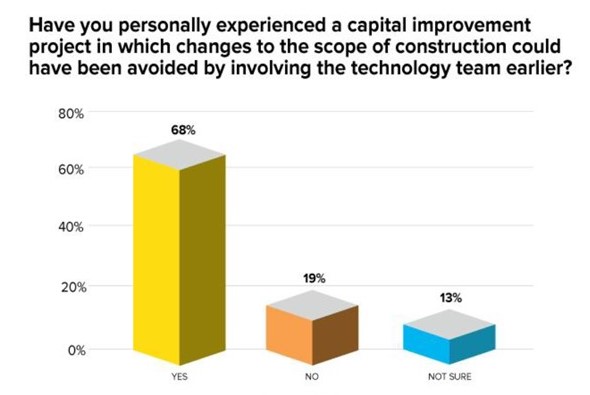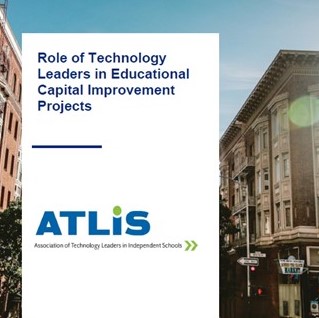As school systems are increasingly complex and interconnected, overlooking something relatively minor in the planning phases of capital improvement projects could have far-reaching implications—especially in the realm of technology. Ensuring system compatibility and avoiding costly mistakes could be as simple as involving the technology team earlier in the planning phases.
According to research released by the Association of Technology Leaders in Independent Schools (ATLIS), technology leaders at schools bring a powerful partnership to the planning team during capital improvement projects. Many schools and districts have experienced firsthand that technology leaders bring a unique perspective on project management, budget optimization on infrastructure solutions, and aligning construction strategies to the school or district’s ed tech goals.
Without the IT voice and partnership, the risk of faulty and inoperable and incompatible systems is just too great.
Mark Hess, Walled Lake Consolidated School District (MI)
“IT input on capital improvement projects is critical,” says Mark Hess, executive manager of instructional technology, assessment, and data analysis at the Walled Lake Consolidated School District in Michigan. “Without the IT voice and partnership, the risk of faulty and inoperable and incompatible systems is just too great. IT staff are no longer just supporting service, they are designing it.”

Inviting the technology team as an afterthought could have costly implications, according to the study. Of the technology leaders who participated in the research, nearly 60 percent at independent schools and 68 percent at public school districts had personally experienced a capital improvement project in which scope changes could have been avoided with earlier involvement of the tech team. Some of these changes were relatively minimal, but approximately 90 percent of independent school participants and 80 percent of public school respondents indicated that up to 10 percent of the value of the total project was sacrificed over issues that could have been avoided.

“The nature of the 21st-century technology team is one that works so closely with so many areas of school life that it develops a well-rounded, empathetic perspective,” notes Tye Campbell, director of technology, Gilman School, Baltimore, Md. “Very few teams in a school have such a view of the organization, and that bodes well for those organizations that value such perspective and leverage it by bringing in the technology team early in any capital improvement project.”
UNEXPECTED SUPPORT
Naturally, tech leaders are confident in their abilities to provide IT infrastructure solutions, but they also have confidence they can serve the team in coordinating emergency planning, designing learning spaces, and value engineering the technology aspect of a project.
“Sometimes the idea of ‘technology’ in capital improvement projects is narrowly defined as simply running some network cables,” says Campbell. “However, with the increasing growth of technology in areas like physical access control, high-speed wireless internet access, teaching and learning, and campus security, coordination with the technology office is more important than ever.”
The school world has evolved so much in the last 10 years from the stand-alone systems, buildings, and applications to a new world of connectedness.
Jeff Mozdzierz, Oakland Schools (MI)
The ubiquitous nature of technology in a school’s ecosystem means IT and tech teams have evolved to meet the need. “The school world has evolved so much in the last 10 years from the stand-alone systems, buildings, and applications to a new world of connectedness,” says Jeff Mozdzierz, director of technology-field services at Oakland Schools in Michigan.
Keeping the school running during and after the project from a tech perspective can ease anxiety for school leaders, according to Renee Ramig, former technology director at Seven Hills School, Walnut Creek, California. “Any tech equipment purchased needs to be incorporated into the current system,” she says. “Often things are purchased that are not needed, again costing money that does not have to be spent. Bottom line is [tech leaders] can save the project money and ensure the current system continues to run during construction.”

Just under 70 percent of private school respondents and 77 percent of public school participants in the ATLIS research reported that the technology teams were brought into the capital improvement project before groundbreaking. The remainder reported being incorporated after groundbreaking, with a small percent noting that the technology team was not involved at any point in the school’s most recent project.
Technology requires many behind the scenes components that need to be considered when planning major capital improvements.
Sarah Rolle, The Elisabeth Morrow School (NJ)
“Technology requires many behind the scenes components that need to be considered when planning major capital improvements,” says Sarah Rolle, director of technology at The Elisabeth Morrow School, Englewood, N.J. “Once plans have been made, it can often be very hard to make changes that technology may require.”
EYE TO THE FUTURE
Sometimes technology teams can find opportunities that will make future expansion for the school easier or less costly. “Being at the table gives you a chance to think big picture on projects like putting in conduit for the football stadium for future data needs or designing a new kitchen or cafeteria that includes pathways for point of sales machines and digital signage,” says Mozdzierz.
Financial discussions about longer-term maintenance of technology should also involve tech leaders—during the initial planning, Campbell says. “In many situations, a large capital improvement project does not include or consider future maintenance and replacement budgeting,” he explains. “What was once new and state-of-the-art becomes old eventually, and must be replaced in like or better quality.”

The full report, “The Role of Technology Leaders in Educational Capital Improvement Projects,” is available at theATLIS.org.
ATLIS member schools can access the report at no cost and non-members can download the full report for $79.
The Association of Technology Leaders in Independent Schools (ATLIS) is a Knowledge Partner for EDspaces.

